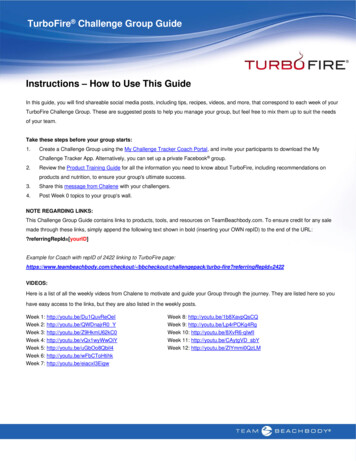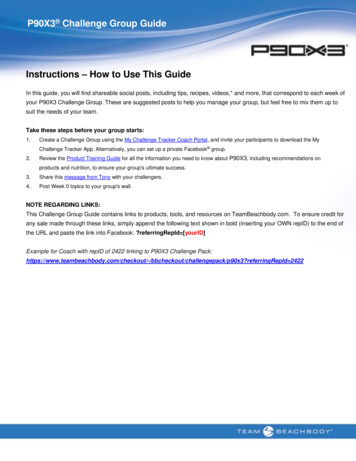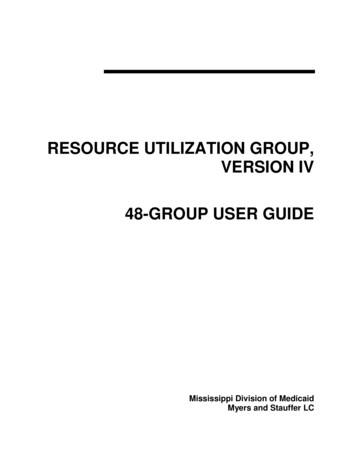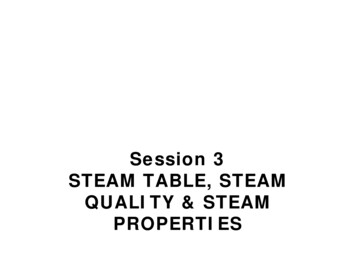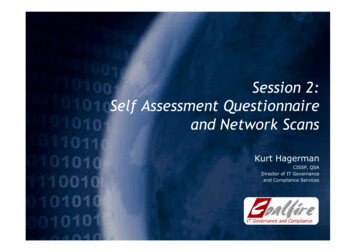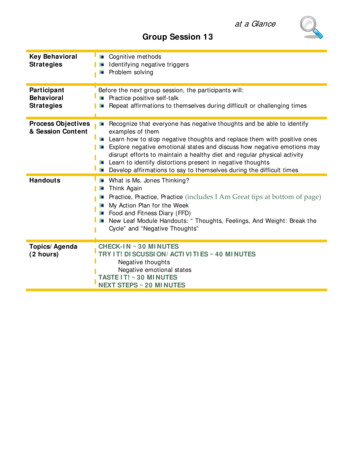
Transcription
at a GlanceGroup Session 13Key sCognitive methodsIdentifying negative triggersProblem solvingBefore the next group session, the participants will:Practice positive self-talkRepeat affirmations to themselves during difficult or challenging timesProcess Objectives& Session ContentRecognize that everyone has negative thoughts and be able to identifyexamples of themLearn how to stop negative thoughts and replace them with positive onesExplore negative emotional states and discuss how negative emotions maydisrupt efforts to maintain a healthy diet and regular physical activityLearn to identify distortions present in negative thoughtsDevelop affirmations to say to themselves during the difficult timesHandoutsWhat is Ms. Jones Thinking?Think AgainPractice, Practice, Practice (includes I Am Great tips at bottom of page)My Action Plan for the WeekFood and Fitness Diary (FFD)New Leaf Module Handouts: “ Thoughts, Feelings, And Weight: Break theCycle” and “Negative Thoughts”Topics/Agenda(2 hours)CHECK-IN 30 MINUTESTRY IT! DISCUSSION/ACTIVITIES 40 MINUTESNegative thoughtsNegative emotional statesTASTE IT! 30 MINUTESNEXT STEPS 20 MINUTES
Agenda for Session #13Page 1 of 5Check- InYour Notes:Sample discussion approach:I. Check-InImportance of supportsystemsLast week we talked about the importance of having support systemsto help you make healthy changes in your life. This form of supportcan come from family or friends and even local resources. Did anyonethink of other community resources?Did you talk with your family members about how they could besupportive? How did they respond? Were you surprised at thereactions or is it what you expected? How do you plan to handlesituations where individuals are not as supportive? What can you do? 30 minutesWhat about changes in your communication style? Did anyonepractice changing your “you” statements to “I” statements?Today we are going to talk about how we communicate with ourselvesand how this self talk can hurt our efforts.1. Challenging negative self talk Discuss the impact of negative self talk Identify helpful tips for overcoming negative feelingsII. Try ItChallenging negativeself talk (“What is Ms.Jones thinking”“Think Again”)Keeping a negativemood logSample discussion approach:Today we’re going to talk about negative thoughts. Everyone hasnegative thoughts at times. How do negative thoughts and badmoods affect your eating habits? Your exercise habits?As you’ve said, negative thoughts and moods can lead you to overeator be inactive. Then afterwards you may feel even worse aboutYour NotesRefer participants to NewLeaf handout “Thoughts,Feelings, and Weight:Break the Cycle” and“Negative Thoughts” foradditional information. Thehandout can serve as aresource for moreinformation but will not becovered in class.
Agenda for Session #13Page 2 of 5Practicing positiveaffirmation (“I amGreat” “PracticePractice Practice”)yourself. A vicious cycle of self-defeat can result. For example,suppose you came home after a hard day at work. You think toyourself, “I’m tired of working so hard. I’m sick of being in this study.I can never eat what I want.” This negative thought might lead you toeat some potato chips. And then you think, “I did it again – I’ll neverlose weight.” Next, you’re discouraged and go on to eat more of them. 40 minutesSometimes we aren’t aware we are having negative thoughts.Negative thinking becomes such a habit for most of us that we tend tobelieve and act on our negative thoughts without even hearing them.The purpose of this session is to help you hear your negative thoughtsand teach you to change them to positive ones.Let’s use an example to help us identify negative attitudes. (DistributeWhat is Ms. Jones Thinking? Handout) Who wants to share herthoughts? What is she thinking? Is this negative way of thinkinghelpful? What are some positive thoughts she may be thinking? Howcan you transfer your negative thoughts into positive ones? One ofthe first steps in changing any behavior is to recognize when negativethoughts are occurring. Then, you can take control of the situationand change your thoughts. Here are some traps that we typically fallinto. (Distribute Think Again worksheets and discuss).2. Keeping a negative mood log Discuss how logs can helpSample discussion approach:As we just mentioned, one of the first steps in changing thesenegative thoughts is identifying when they happen and if possibledetermine what is triggering these negative moods so that we can tryto avoid the triggers – remember this topic from a couple of weeksago? One way we can do this is to keep a record of our feelings andour reaction to them. One of the components of the Food and FitnessDiary is related to this topic. How many people have been tracking
Agenda for Session #13Page 3 of 5their moods on each day? Have you noticed any patterns? Even ifyou have not been tracking these feelings, you may be able to recallthe ‘bad days.’ What did these days have in common? Did youexercise that day? We have talked before about the use of exercise asa potential stress reliever. Exercise can also help you change yourmood. Has anyone experienced this? For instance, walking around theblock a few times after eating a whole bag of potato chips may helpyou change those negative feelings. Instead of thinking, “Great – nowI will never lose weight, I might as well have that piece of cake, too”you can go for that walk and think, “Well I shouldn’t have eaten thewhole bag of potato chips and will be more careful next time, but atleast I was able to get a walk in and use some of those calories.”If you have not been doing so, we recommend that you startrecording your emotions. Pay close attention to those ‘bad days.’Look for potential triggers and start recognizing when those negativethoughts creep in so you can take charge and change them.3. Practicing positive affirmation Practice using positive affirmationSample discussion approach:It is important to practice using positive affirmation so that when youdo have negative thoughts, you can talk yourself out of it. Here aresome positive reaffirmations related to body image and health(Distribute I AM Great worksheet). Which of these statements canyou identify with? Which ones can you use? Are there other ways tofeel good about yourself? What are some other statements you cansay to yourself when you are feeling down?Let’s use the Practice worksheet to help us transfer some of ournegative thoughts into positive ones. (Distribute Practice, Practice,Practice worksheet).
Agenda for Session #13Page 4 of 5Purpose:III. Taste It To taste and discuss healthy dessert options.Learn to incorporate desserts into a healthy meal.Materials/Equipment: 2 –3 flavored lowfat/fat-free frozen desserts, sorbets, sherberts oryogurt. May have samples of ice cream for comparison to modified icecream. Samples of desserts presented and labels, cups, spoons, napkins,drinking waterTHEME: Healthy AlternativeDesserts 30 minutesHealthy Alternative DessertsDesserts are often difficult for people to control when they are tryingto make healthy changes. Keeping undesired foods out of reach andhaving desired alternatives for appropriate occasions is helpful insituational and portion control. Moderate amounts of desserts can bepart of a healthy meal plan.Sample discussion approach:How many of you enjoy a dessert now and then? Desserts can bedifficult to control when you are trying to make healthy eatingchanges.In what situations do you find yourself that makes it difficult to controldesserts? Some examples include social occasions: birthdays,anniversary, holidays, church socials, etc., dining out, gifts of sweets,desserts brought to workplace by co-workers. What can you do inthese situations to avoid temptation?What are some feelings or emotions that we sometimes associate withYour Notes
Agenda for Session #13Page 5 of 5desserts? Often desserts are used for various celebrations or comfort –remind us of our childhood and are used sometimes as rewards. Becareful when using desserts this way as it can lead to overeating andemotional guilt.What are your thoughts or concerns about desserts when you are inthese situations? You may tend to eat too much or feel that dessertsare not good for you. This can make you feel guilty. Eating dessertsshould not make you feel bad, so long as you can eat healthierdesserts and do so in moderation. However, know your limits. If youcannot control how much you eat, then try to limit these foods.IV. Next StepsPlan for the WeekTracking (SelfMonitoring)What to Expect NextWeek 30 minutes1. Plan for the WeekParticipants write a weekly action plan on the inside cover of the diaryin at least the following areas:--Practice using positive affirmation--Physical activity links--Participant choice2. Tracking (Self-Monitoring):The recommended tracking for the week is:a. Write down all the food you eat and drink every day.b. Calculate the calories from the foods you eat and drink, total,and summarize for at least 3 days.c. Keep track of servings of fruits and vegetables each day.d. Write down the minutes of exercise above your normalroutine.3. What to expect next week Bring comfortable clothes and shoes for the Do It!
What is Ms. Jones Thinking?Ms. Jones has had a tough day.She woke up late for work and had toskip breakfast. She was hungry, so sheate two donuts at her morning meeting.Her day was very busy and she was notable to go on her usual walk during lunch. In fact, she did nothave time for lunch at all.At 3:00pm, she was so hungry that she had a candy bar andpackage of peanut butter crackers to tide her over until dinner.When she comes home from work, she finds that her husband haspicked up fast food for dinner.How does she feel? What is she thinking? How can she changeany negative thoughts into positive ones?Version 1.15/31/2005Session 13
Think AgainFirst thoughtWhat you’re doing Think again“I had potato chips atlunch, so I failed mydiet.”All or nothing thinkingyou are looking at thingsin black or white, nograys“I had potato chips forlunch, so I need to beextra careful with mycalories at dinner.”“I should have workedharder to lose weight.”Should statementsyou criticize yourself orothers with “shoulds,musts and should not”“I have not worked ashard as I could have so Iam going to startexercising one more dayof the week.”“I did not lose as muchweight as her.”Discounting the positivesyou concentrate on thenegatives and ignore thepositives“Wow. Some peoplehave really lost a lot ofweight. I need to findout what they are doingso I can lose even moreweight.”“If I make anothermistake, I should just dropout of the program.”Thinking the worstyou blow things out ofproportion“This program is a lotharder than I thought itwas going to be, but Iam determined to workhard and do the best Ican to make changes inmy life.”“I always eat too much.I’ll always be fat.”Labelingyou view a singlenegative event as alifelong pattern“I ate too much today. Ineed to go for an extralong walk and rememberthat tomorrow is anotherday.”“My sister has not calledme in awhile. She isangry at me forchanging my lifestyle.”Jumping to conclusionsyou assume the worstbased on little or noinformation“I wonder if my sister isOK. I have not heardfrom her in awhile.”Version 1.15/31/2005Session 13
Practice, Practice, PracticeNegative ThoughtSTOPPositive ThoughtExamples of positive thoughts:I can do anything I set my mind toIf she can do it, I can do itI feel good when I exerciseI like the way I feel after I eat a healthy mealI can say no to things that are not important to meI accept myself for who I amI will work hard to be a better meI look nice todayThis is a great color on meI have great eyesI am a good personI have the will power to changeVersion 1.15/31/2005Session 13
My Action Plan for the WeekGOAL #1: Think positive thoughts3 positive statements I will think this week1.2.3.GOAL #2: 30 minutes of moderate physical activity on 5 days of the aturdayActivityMinutesTOTALGOAL #3: Keep track of all food/drinks and physical activity in the Foodand Fitness Diary every dayThings that may get in my way1.2.3.How I can make sure they don’t1.2.3.GOAL #4: My other goal is:What I need to do to reach this goal:Version 1.15/31/2005Session 13
3. Practicing positive affirmation Practice using positive affirmation Sample discussion approach: It is important to practice using positive affirmation so that when you do have negative thoughts, you can talk yourself out of it. Here are some positive reaffirmations related to body imag

